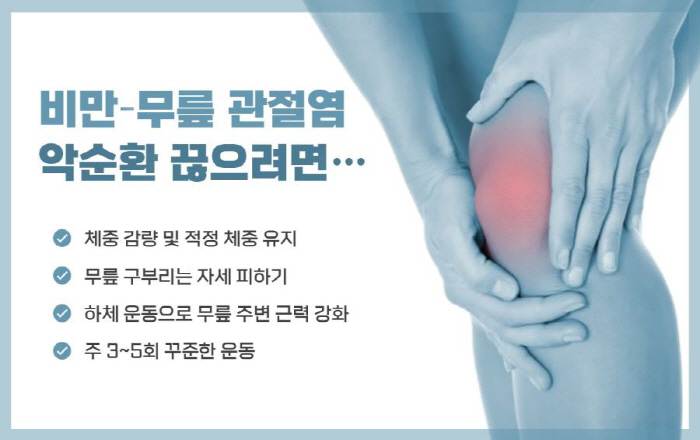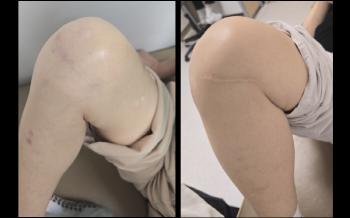There's another reason to lose weight...The prevalence of knee arthritis, which is obese, is 1.8 times higher
|
Repeated application of excessive loads will accelerate the onset of degenerative arthritis by progressing fine damage to cartilage that protects knee joints and causing joint pain and functional degradation. As a result, physical activity decreases, creating a vicious cycle of weight gain and arthritis accelerating again. According to data from the National Health Insurance Corporation (2022), the prevalence of knee arthritis in obese groups with a body mass index (BMI) of 25 or higher was about 1.8 times higher than in the normal weight group.
"When you gain weight, physical pressure is put on your knee joints, and obese women have four times higher risk of arthritis than normal-weight women," said Himchan Hospital, head of the orthopedic Junghoon Lee medical center. "When an obese person loses 5kg of weight, arthritis symptoms are reduced by 50%."
◇Overweight to exacerbate arthritis...Risk of occurrence up to 1.8x
In fact, the association between obesity and knee arthritis has been proven through domestic and international studies.
A study published in the 2023 international journal 『Scientific Reports』 analyzed health examination data of 1.1 million adults over the age of 50 in Korea to investigate the effect of obesity on the risk of developing knee arthritis.
As a result, the obesity group had a 1.28 times higher risk of knee arthritis than the general population, especially in the case of the obesity group accompanied by abdominal obesity (90cm for men with waist circumference and 85cm for women or more), the risk was 1.41 times higher than that of the general population. In addition, those who improved their obesity status for two years had a reduced risk of developing knee arthritis by 10 to 11.6%.
In particular, in the past, the association between obesity and arthritis has been interpreted mainly in terms of physical loads applied to the knee. However, recent studies note the chemical effects of adipose tissue.
According to a paper published in the Journal of Clinical and Translational Medicine in 2023, the rate of arthritis progression in obese patients was faster than in normal-weight patients. Adipokines and cytokines, which promote inflammation, are secreted from fat cells in obese patients, and these inflammatory substances circulate throughout the body in blood and attack chondrocytes and synovial membranes inside knee joints to promote damage. It also amplifies intra-articular inflammation, exacerbating arthritis symptoms. In other words, obesity is a double attack that weighs on joints with excessive weight and destroys joints with inflammatory bombs.
◇Recommended low-impact aerobic exercise such as swimming and indoor cycling rather than intense exercise
The most fundamental and effective way to break the vicious cycle of obesity and arthritis is weight loss. Losing weight immediately reduces the physical load on the joint and reduces the secretion of inflammatory adipokines, resulting in the effect of killing two birds with one stone to improve the joint environment.
In addition, you should avoid bending your knees for a long time during your daily life and change your habits of sitting on the floor or squatting and mopping as much as possible. Usually, when you have arthritis, you have pain or you don't exercise because you need to save your knees. However, it is necessary to strengthen the strength around the knee with proper lower body strength exercise. When the muscles and ligaments that support the joint weaken, the burden the joint has to bear increases.
However, it is essential for obese and knee arthritis patients to choose exercise that can maintain muscle strength and control weight while underweight. Low-impact aerobic exercises such as swimming, aquarobics, indoor cycling, and light walking are recommended rather than intense exercise. Exercise in water is effective in strengthening the muscles around the joints as there is little load on the joints thanks to buoyancy. Indoor cycling exercises in a sitting position, so you can strengthen your thigh muscles while minimizing your weight load. It is also helpful to sit in a chair and repeat a daily exercise that strengthens the front quadriceps of the thigh for more than 10 minutes. Muscles around the joint distribute the load to prevent joint damage. Exercise continues three to five times a week.
Himchan Hospital, Director of Orthopaedic Surgery Junghoon Lee Medical Center, said "Losing 5-10% of your weight after arthritis pain can significantly reduce pain and slow the progression of arthritis."For arthritis patients visiting the clinic, we emphasize maintaining an appropriate weight and finding an exercise method that suits them, doing it regularly, and having a good lifestyle. "
|
This article was translated by Naver AI translator.





